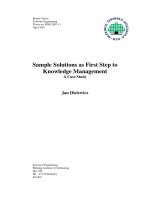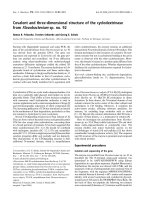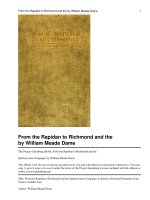The first step to isolate and determine the structure of some organic compounds of the Tich Duong mushrooms (Rhopalocnemis phalloides Junghun) collected in Son La
Bạn đang xem bản rút gọn của tài liệu. Xem và tải ngay bản đầy đủ của tài liệu tại đây (171.38 KB, 5 trang )
TẠP CHÍ KHOA HỌC − SỐ 31/2019
117
THE FIRST STEP TO ISOLATE AND DETERMINE THE STRUCTURE
OF SOME ORGANIC COMPOUNDS OF THE
THE TICH DUONG
MUSHROOMS (RHOPALOCNEMIS PHALLOIDES JUNGHUN)
COLLECTED IN SON LA
Pham Van Cong, Nguyen Thi Hai, Seng Cay Hom Ma Ni,
Son Am Phon Keo Pa Sot
Tay Bac University
Abstract: 2- (3,4-hydroxyphenyl) chroman-3,5,7-triol has been isolated from the
Rhopalocnemis phalloides junghun. Chemical structure of these compounds have been
confirmed by NMR (1D and 2D) and compared with reference .
Keywords: Balanophoraceae, Rhopalocnemis phalloides junghun, phenolic
Email:
Received 24 April 2019
Accepted for publication 25 May 2019
1. PREAMBLE
Tich duong mushrooms has the scientific name of Rhopalocnemis phalloides junghun,
belonging to parasitic, non-chlorophyll fungus; tubers are 2-10cm large, smooth or
melancholy; the stem is 2-10 cm long, along with 6-20 cm long oval flowers, at the young
age, there is a flowering leaf. Single flowers between feathers; male flowers with 5 teeth,
including the heroic part; female flowers with perches have 2 long stents. Positive fungi
are usually reddish-brown or yellowish, ivory, often found on parasitic roots of tree roots.
Tich duong mushrooms is a precious medicinal herb, which has long been widely used
in traditional medicine; It has a sweet taste, mild temperament, has a kidney-replenishing
effect, has a strong back and lumbar field, used in cases where men are impotent, women
are infertile, blood is dry, constipation, back weak pillows
Regarding chemical composition: in Tich duong mushrooms, fat, derivatives of
cinnamic acid, tannin, lignan, glycosides,... [5-7] were discovered.
According to recent studies, Tich duong mushrooms fungi contain a number of
compounds that are able to resist oxidation, inhibit HIV, hypoglycemia, and the ability of
TRƯỜNG ĐẠI HỌC THỦ ĐÔ H
118
NỘI
some cytotoxic cytotoxic cells [8-10]. This paper will inform the isolation and structure of
some compounds from n-hexane, ethyl acetate extract of the Tich duong mushrooms in
Son La.
2. EXPERIMENTAL AND RESEARCH METHODS
2.1. Plant samples
Tich duong mushrooms (4 kg of fresh plants) were harvested in October 2018 in Bac
Yen mountain area - Son La. Scientific name is Rhopalocnemis phalloides junghun was
identified by Pham Quynh Anh, Department of Biochemistry – Tay Bac University
2.2. Chemicals and equipment
- Thin layer chromatography (TLC): Performed on a thin, pre-coated sheet of DCAlufolien 60 F254 (Merck-Germany). Detect the substance with ultraviolet light in two
wavelengths 254 and 368 nm, sulfuric acid reagent (H2SO4 + methanol + vanillin) dried at
a temperature of> 100 oC until the color appears.
- Column chromatography (CC) is carried out with normal phase adsorbents (Silica gel
60-160 and 240-430 mesh, Merck).
- IR spectrum (KBr) is recorded on the machine SIMP4.
- Flow point is measured on Electrothermal IA- 9200 (UK).
- High resolution mass spectra HR-ESI-MS measured on the mass spectrometer of the
FT-ICR / MS.
- Nuclear magnetic resonance spectrum (NMR) was measured on the Bruker AM500
FT-NMRSpectrometer.
2.3. Extraction and isolation of substances
Tich duong mushrooms has a mass of 0.7 kg (dry, powder) soaked in solvent H2O:
MeOH = 20:80 (5 liters). Samples are soaked for 1 week, ultrasonic extraction many times.
Filter the yellow and residue solution. The residue is further soaked in solvent H2O:
MeOH. Repeat several times until the filtered water remains light yellow. The solution was
carried out to store the spinning machine, resulting in a high total of dark yellow, liquid,
viscous (LT).
Then, the total height was treated according to the fractional extraction direction:
Dissolve high alcohol in 1 liter of water, stir well then ultrasound to completely dissolve
and then extract with the solvents: n-hexane, ethyl acetate followed ratio 1: 1 (extract each
segment 3 times), extract the fractional extracts, store and recover the solvent under
pressure to reduce those segments to the corresponding residue: n-hexane residue (denoted
TẠP CHÍ KHOA HỌC − SỐ 31/2019
119
as LTH, 1, 42g), ethyl acetate residue (LTE, 11.69 g). The n-hexane, ethyl acetate residues
are separated on the silica gel column with the elution solvent system as follows: the LTH
residue with the n-hexane-ethyl acetate system has increased polarization, the residue of
LTE using the elution solvent system ( EtOAc: MeOH) = (80:20), (80:20), (70:30),
(60:40), (50:50) to collect segments. After purification by re-running the silica gel phase
often repeat or recrystallize from the fractions obtained with clean compounds, denoted by:
LTH1 (115 mg); LTE1 (189 mg).
3. RESULTS
3.1. Compound 1 (LTH1)
+ 1H NMR spectrum of compound 1 has 5 protons, including:
- A proton of R-CH3 group has a chemical shift at 0.8 ppm.
- A proton with a chemical shift at 1.3 ppm is expected to be a proton of the R-CH2-R
group
- A proton with a chemical shift at 2.3 ppm is expected to be a proton of the R-CO-CH
group
- Two equivalent protons, with a chemical displacement of 4.2 ppm are expected to be
the proton of the group –CH2-OFrom the analysis of spectral data of LTH1 and comparison with reference materials, it
is possible to confirm that LTH1 belongs to trigixerite group:
3.2. Compound 2 (LTE1)
Data on the 1H-NMR spectrum and the 1H-NMR spectrum of the E1 substance
showed 14 protons in the molecule. 13C-NMR spectral data show the signal of 15 carbon.
Spectral line characteristics and atomic number correlations C and H in E1 molecule allow
prediction of E1 as a substance of frame flavan
+ 1H-NMR spectrum (MeOH, 500MHz)
-NMR spectrum of this substance shows cluster signal of 4 aromatic proton signals of
group -CH with 2 pairs of equivalent protons, having a chemical shift at 6,729 ppm (2H, d,
J = 8.36 Hz) and 7.239 ppm (2H, d, J = 8.36 Hz) suggests that the aromatic ring is replaced
twice in the para position. A -CH2 group with two multiplet signals of two protons in ở =
TRƯỜNG ĐẠI HỌC THỦ ĐÔ H
120
NỘI
2.50 and 2.71 ppm respectively. In addition, the signal δ = 5,734 and 5,904 ppm are 2
protons of the aromatic ring indicating that positions 7 and 5 have been replaced.
+ 13C-NMR spectrum (CDCl3, 125MHz) 13C-NMR spectrum of E1 shows 14 carbon
signals, of which 1 group signal –CH2 characteristic at δ = 28.2ppm at high field, 4 signals
of group –CH aromatic (C cycle), with the chemical displacement là = 114ppm (C5 ', C3')
and δ = 128 ppm (C6 ', C2') corresponding to the four protons above. The signals in the
98.4 to 130 ppm transition range show the signals of group-CH of the round.
The group position of –CH2 in position C4 was confirmed by interactions via a link
between C4 and 2 H4 (1-2) protons on the HSQC spectrum.
Similarly, the positions of the –CH protons of rings A and B in positions 3, 2, 8 and 6
are expressed through direct C-H interactions on the spectrum of spectra.
The position of the three –OH groups was confirmed by the interactions on the HMBC
spectrum of H4 (1) with C9, C10 and C3; interaction of H2 with C9, C1 ', C6' and C2 ';
interaction of H6 with C10, C8 and C7; Interaction of H8 with C10, C7 and C6.
From analyzing the spectrum data of E1 and comparing with the reference, it is
confirmed that E1 is 2- (3,4-hydroxyphenyl) chroman-3,5,7-triol.
Structural formula of LTE1E1:
OH
OH
O
HO
OH
OH
4. CONCLUSION
By repeating chromatographic method, 2 compounds from n-hexane and ethyl acetate
segments of the positive fungi (Rhopalocnemis phalloides junghun) were isolated.
Combining methods of infrared spectroscopy, mass spectra, one-way, two-dimensional
nuclear magnetic resonance spectroscopy, and comparing their spectral data with published
literature, the chemical structure of triglixerite (1), 2- (3,4-dihydroxyphenyl) chromane3,5,7-triol (2).
This is the first time these compounds have been isolated from the Tich duong
mushrooms collected in Son La.
TẠP CHÍ KHOA HỌC − SỐ 31/2019
121
REFERENCES
1.
Pham Hoang Ho (2004), “Vietnam Grass”, Episode 2, Young Publisher, pp. 140-141
2.
Do Huy Bich and colleagues, Medicinal plants and medicinal animals in Vietnam, Publisher.
Science and Technology, T1, Tr. 555 (2006).
3.
Do Tat Loi (2000), Vietnamese medicinal herbs and herbs, Publisher. Medicine, Tr. 914.
4.
Cam Thi Dinh, Nguyen Thi Hong Van, Tran Thi Quynh Trang, Phan Anh Tuan, Nguyen
Thanh Huong, Pham Quoc Long (2014), Study on chemical composition of ethyl acetate
extract of poplar tree (Balanophora laxiflora Hemsl.) In Vietnam, Journal of Science and
Technology, 52 (5A), 96-100.
5.
Gai-Mei She, Ying-Jun Zhang, Chong-Ren Yang (2009), Phenolic Constituents from
Balanophora laxiflora with DPPH Radical-Scavenging Activity, Chemistry Biodiversity, 6 (6),
875-880.
6.
Xiaohong Wang, Zizhen Liu, Wenlin Qiao, Ruiyang Cheng, Bin Liu and Gaimei She (2012),
Phytochemicals and biological studies of plants from the genus Balanophora, Chemistry
Central Journal, 10, 1186-1752.
7.
Jiang ZH., Wen XY., Tanaka T., Wu SY., Liu Z., Iwata H., Hirose Y., Wu S., Kouno I.
(2008), Cytotoxic Hydrolyzable Tannins from Balanophora japonica, J. Nat. Prod., 71(4), 719723.
8.
Wen-Fei Chiou, Chien-Chang Shen and Lie-Chwen Lin (2011), Anti-Inflammatory Principles
from Balanophora laxiflora, Journal of Food and Drug Analysis, 19(4), 502-508.
9.
Shang-Tse Ho, Yu-Tang Tung, Chi-Chang Huang, Chao-Lin Kuo, Chi-Chen Lin, Suh-Ching
Yang, and Jyh-Horng Wu (2012), The Hypouricemic Effect of Balanophora laxiflora Extracts
and Derived Phytochemicals in Hyperuricemic Mice, Evidence - Based Complementary and
Alternative Medicine 2012, 1-7.
10. Babady-Byla, Werner Herz (1996), Triterpenes and 1-(ω hydroxyceratyl)glycerols from
Pentaclethra eetveldeana root bark, Phytochemistry, 42(2), 501- 504.
BƯỚC ĐẦU PHÂN LẬP VÀ XÁC ĐỊNH CẤU TRÚC MỘT SỐ HỢP
CHẤT HỮU CƠ CỦA CÂY NẤM TÍCH DƯƠNG
(RHOPALOCNEMIS PHALLOIDES JUNGHUN) THU TẠI SƠN LA
Tóm tắ
tắt: 2-(3,4- hydroxyphenyl) chroman-3,5,7-triol đã được phân lập từ cây nấm tích
dương Rhopalocnemis phalloides junghun. Cấu trúc hóa học của các hợp chất này được
xác định bằng các phương pháp phổ cộng hưởng từ hạt nhân 1 chiều và 2 chiều cũng như
kết hợp so sánh với tài liệu tham khảo.
Từ khóa: Balanophoraceae, Rhopalocnemis phalloides junghun, phenolic.









